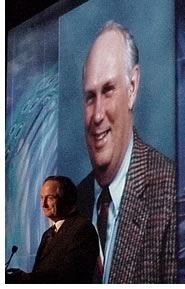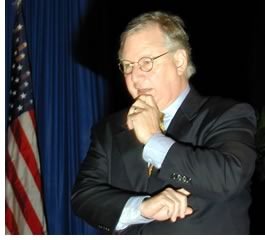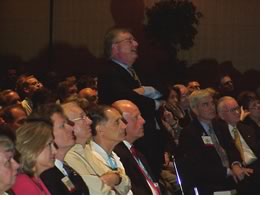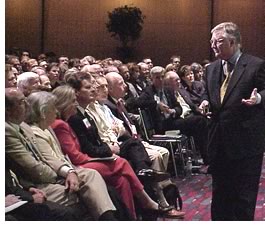
Keynote speaker on talent: "Women Rule!" On clients, "Women Roar!"
Opening session begins with reflection, tributes
 Welcome:
"Who could have predicted the changes that have taken place in the
world since we gathered one year ago for the AIA convention," AIA
Executive Vice President/CEO Norman L. Koonce, FAIA, mused as he welcomed
a full-house audience to the opening session of the AIA national convention
May 9 in Charlotte. Who could have predicted, Koonce queried, the events
of September 11, and all its ramifications? "In the face of these
daunting challenges, these conventions are affirmations of hope …
and never has the relevance of our society been more clear," he said.
Welcome:
"Who could have predicted the changes that have taken place in the
world since we gathered one year ago for the AIA convention," AIA
Executive Vice President/CEO Norman L. Koonce, FAIA, mused as he welcomed
a full-house audience to the opening session of the AIA national convention
May 9 in Charlotte. Who could have predicted, Koonce queried, the events
of September 11, and all its ramifications? "In the face of these
daunting challenges, these conventions are affirmations of hope …
and never has the relevance of our society been more clear," he said.
Tribute: Koonce also read a special tribute to the late John C. Gaillard and his wife Anne, for their 20 years of service and dedication to AIA conventions. Gaillard passed away suddenly just after the 2001 convention in Denver last May.
Cornerstone Partner of the Year: AIA President Gordon H. Chong, FAIA, spoke on the importance of collaboration within the profession and presented Norbert Young, FAIA, president of McGraw-Hill Construction, with the AIA/American Architectural Foundation's 2002 Cornerstone Award celebrating McGraw-Hill as the "partner of the year." Among its many joint activities with the Institute, McGraw-Hill is the sponsor of all three convention theme sessions.
It's All About Design: "There's a heart that beats here at this convention—it's alive," Chong declared "It's design." He explained that the theme and the syllabus for the three days of the convention are exploring the power of design—the architect's core competency—which he believes is on a threshold of major change. Paraphrasing The Tipping Point by Malcolm Gladwell (a best-selling book that characterizes defining moments of critical mass for emerging, society-changing innovations), Chong said he believes strongly that design is at its own tipping point—"for our clients, our communities, and for us as a profession. . . . The very nature of how business functions is a design problem," Chong said.
 Peters
on the Five Changes
Peters
on the Five Changes
Chong introduced keynote speaker Tom Peters—author of hundreds of articles and books, including the now-classic In Search of Excellence and president of the Tom Peters Company—as the Los Angeles Times-acclaimed "father of the post-Modern corporation."
Peters intimated that he was intimidated to address the audience of architects. It was not, he said, because he is an architecture-school first-semester dropout. (He graduated Cornell University with a civil engineering degree "not by choice," he said, but rather due to his having the "aesthetic sense of a shrimp.") He is awed, he said, by the possibilities of the potential power of design.
Peters structured his extremely well-received address
based on what he calls The Five Changes:
1. The world changes
The world is changing, Peters said, and the current pace of change will
only accelerate. The result, of course, is confusion. "I don't know
what the built environment means anymore," he said.
 2.
The work changes
2.
The work changes
The world will be rocked mightily by the way work changes, Peters said;
there will be a white-collar revolution. Some 75 percent of administrative,
"back-room," and financial jobs will be digitized in three years,
according to the January 28 issue of Business
Week, he said. This means tall towers for businesses will be history,
as "e-lancers," people working individually and in small firms,
will change the way we think about the workplace. The events of September
11 have reinforced this trend. "People are not going to live in high
towers. It's over, period," Peters said. We are moving to a low-rise
work world; Silicon Valley, Calif., or the Research Triangle in North
Carolina will be the models.
3. The firm changes
We're re-imaging the model for the professional services firm, and Peters'
bottom-line advice to AIA members is "eat or be eaten." If the
architect becomes an integrated services provider, creativity may be drained
from the process. "I'm not sure you can have your cake and eat it
too," he said.
Peters suggested that architects actually are providing experiences. If you travel up the hierarchy of business, raw materials is at the bottom, then services, then goods, then experiences. Architects offer many difference services hodge-podge, but do they offer a cohesive experience? He asked: "What is the big idea that hangs it all together?" Creating a design experience would be taking design to a higher level than in the past, he posited.
It all adds up to "the Brand," Peters said. We need to decide who we are, and what our story is. "Brands are not nouns, but verbs," he admonished, quoting Jean-Marie Dru, author of Disruption. The architecture profession is woefully under-branded, he says.
 4.
The talent changes
4.
The talent changes
As the brand changes, so does the talent. And Peters' main message was
"Women rule!" Female managers outshine their counterparts in
almost every measure, he said, quoting a 2000 special report in Business
Week. He deplored the low percentage of women in the profession
and said that the intelligence of a truly modern society must be female.
5. The client changes
Peter's main message on client changes is that "Women roar!"
The potential of female consumer power as a trend "is even bigger
than the Internet," he said. Women purchase the majority of services
and make most of the financial decisions—dominating commercial as
well as residential markets. And women buy things differently than men—women
create connections when they buy; men simply make transactions. He encouraged
the audience to think about whether men truly can design for women's needs.
In sum, Peters urged architects to "think and rethink what you are about" and consider the awesome power of "the real potential of architects to change the world."
Tom Peters has made his slide presentation available to architects via his Web site.
Copyright 2002 The American Institute of Architects. All rights reserved.
![]()
|
|
|